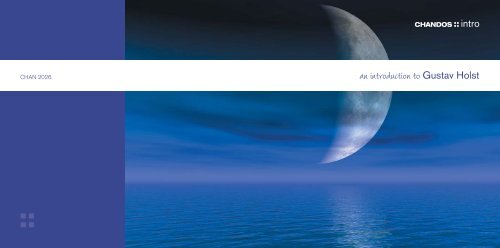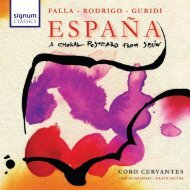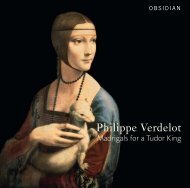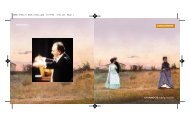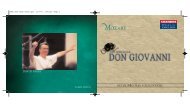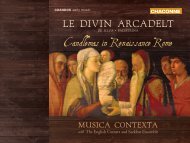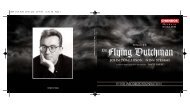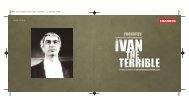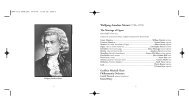an introduction to Gustav Holst - Chandos
an introduction to Gustav Holst - Chandos
an introduction to Gustav Holst - Chandos
Create successful ePaper yourself
Turn your PDF publications into a flip-book with our unique Google optimized e-Paper software.
CHANDOS<br />
:: intro<br />
CHAN 2026<br />
<strong>an</strong> <strong>introduction</strong> <strong>to</strong> <strong>Gustav</strong> <strong>Holst</strong><br />
::<br />
17<br />
CHAN 2026 Book.indd 16-17 30/7/06 13:22:07
2<br />
::<br />
<strong>Gustav</strong> <strong>Holst</strong> (1874–1934)<br />
CHANDOS :: intro<br />
Classical music is inaccessible <strong>an</strong>d diffi cult.<br />
It’s surprising how m<strong>an</strong>y people still believe<br />
the above statement <strong>to</strong> be true, so this new series<br />
from Ch<strong>an</strong>dos is not only welcome, it’s also very<br />
necessary.<br />
I was lucky enough <strong>to</strong> stumble upon the<br />
wonderful world of the classics when I was a<br />
child, <strong>an</strong>d I’ve often contemplated how much<br />
poorer my life would have been had I not done<br />
so. As you have taken the fi rst step by buying this<br />
CD, I guar<strong>an</strong>tee that you will share the delights<br />
of this epic journey of discovery. Each CD in the<br />
series features the orchestral music of a specifi c<br />
composer, with a selection of his ‘greatest hits’<br />
played by <strong>to</strong>p quality performers. It will give you<br />
a good fl avour of the composer’s style, but you<br />
won’t fi nd <strong>an</strong>y nasty surprises – all the music is<br />
inst<strong>an</strong>tly accessible <strong>an</strong>d appealing. The discs are<br />
beautifully presented, <strong>an</strong>d very good value for<br />
money, <strong>to</strong>o.<br />
I sincerely hope this CD marks the start of<br />
your own lifelong passion for classical music.<br />
© 2006 John Brunning<br />
Classic FM presenter<br />
The Pl<strong>an</strong>ets, Op. 32* 52:28<br />
Suite for large orchestra<br />
1 1 Mars. The Bringer of War 7:25<br />
2 2 Venus. The Bringer of Peace 9:02<br />
3 3 Mercury. The Winged Messenger 4:12<br />
4 4 Jupiter. The Bringer of Jollity 7:30<br />
5 5 Saturn. The Bringer of Old Age 10:03<br />
6 6 Ur<strong>an</strong>us. The Magici<strong>an</strong> 6:04<br />
7 7 Neptune. The Mystic 8:09<br />
women’s voices of SNO Chorus<br />
Brook Green Suite† 7:21<br />
for stings<br />
8 I Prelude. Allegret<strong>to</strong> 1:57<br />
9 II Air. And<strong>an</strong>te – Poco <strong>an</strong>ima<strong>to</strong> 2:34<br />
10 III D<strong>an</strong>ce. Allegro 2:48<br />
3<br />
CHAN 2026 Book.indd 2-3 30/7/06 13:22:04
St Paul’s Suite, Op. 29 No. 2† 13:01<br />
for strings<br />
11 I Jig. Vivace 3:12<br />
12 II Ostina<strong>to</strong>. Pres<strong>to</strong> 1:59<br />
13 III Intermezzo. And<strong>an</strong>te con mo<strong>to</strong> – Vivace – Tempo I 4:17<br />
14 IV Finale (The Dargason). Allegro 3:32<br />
Total time 72:50<br />
Scottish National Orchestra*<br />
Edwin Paling leader<br />
City of London Sinfonia†<br />
Sir Alex<strong>an</strong>der Gibson*<br />
Richard Hickox†<br />
Although of Baltic extraction – his great-gr<strong>an</strong>dfather had served<br />
at the Imperial Russi<strong>an</strong> court <strong>an</strong>d had come <strong>to</strong> Engl<strong>an</strong>d from the<br />
Latvi<strong>an</strong> port of Riga early in the nineteenth century – <strong>Gustav</strong> <strong>Holst</strong><br />
was born in Cheltenham, Gloucestershire in<strong>to</strong> a musical family.<br />
He was as infused with the spirit of the West Country as were those<br />
other architects of the new English music: Parry, Elgar, Vaugh<strong>an</strong><br />
Williams <strong>an</strong>d Herbert Howells. Yet, as it had been benefi cial for<br />
British musici<strong>an</strong>s in the nineteenth century <strong>to</strong> espouse all things<br />
Germ<strong>an</strong>, <strong>Holst</strong> was born ‘von <strong>Holst</strong>’ <strong>an</strong>d was known as such<br />
for more th<strong>an</strong> two thirds of his life (in letters Vaugh<strong>an</strong> Williams<br />
called him ‘Dear V’). He only ch<strong>an</strong>ged his name because of wartime<br />
<strong>an</strong>ti-Germ<strong>an</strong> sentiment – in June 1915 he was even harrassed by<br />
the police on account of his presumed Germ<strong>an</strong> nationality.<br />
<strong>Holst</strong>’s name has long been linked with that of Vaugh<strong>an</strong><br />
Williams; he <strong>an</strong>d <strong>Holst</strong> were friends, each the other’s critical<br />
sounding board. Their careers r<strong>an</strong> in parallel, both were pupils<br />
of St<strong>an</strong>ford, both later taught at the Royal College of Music, both<br />
were immensely infl uential in their day. (Yet there the similarity<br />
ended, for Vaugh<strong>an</strong> Williams was fi n<strong>an</strong>cially independent whereas<br />
<strong>Holst</strong> had <strong>to</strong> earn his living.) The fi rst musical allegi<strong>an</strong>ces of<br />
<strong>Holst</strong> were <strong>to</strong> Grieg <strong>an</strong>d <strong>to</strong> Wagner, <strong>an</strong>d while St<strong>an</strong>ford may have<br />
approved of the former he was not always so enthusiastic about<br />
the latter. <strong>Holst</strong> himself recoiled from the limitations of his prentice<br />
works, putting them away <strong>an</strong>d inventing the now celebrated<br />
phrase ‘early horrors’ <strong>to</strong> describe them. Times ch<strong>an</strong>ge, <strong>an</strong>d now<br />
that <strong>Holst</strong>’s mature music is known <strong>an</strong>d this early music has been<br />
performed, we have discovered that much of it is surprisingly<br />
worthwhile, if atypical of the mature composer.<br />
From the beginning <strong>Holst</strong> had a brilli<strong>an</strong>t comm<strong>an</strong>d of the<br />
orchestra. Coming from a comparatively poor family background,<br />
he had <strong>to</strong> make his own way <strong>an</strong>d, at fi rst, this me<strong>an</strong>t playing the<br />
trombone (in the Scottish Orchestra <strong>an</strong>d the orchestra of the Carl<br />
<strong>an</strong> <strong>introduction</strong> <strong>to</strong> <strong>Gustav</strong> <strong>Holst</strong><br />
4 5<br />
CHAN 2026 Book.indd 4-5 30/7/06 13:22:06
Rosa Opera <strong>an</strong>d, in summer seasons, with popular b<strong>an</strong>ds) – a<br />
sure way of gaining a practical underst<strong>an</strong>ding of the orchestra<br />
from the inside. He had <strong>to</strong> live, though, <strong>an</strong>d once he had been<br />
appointed music master at the then new St Paul’s Girls School<br />
in Hammersmith, in 1905, most of his life was spent teaching. He<br />
was only able <strong>to</strong> support himself as a composer in the last years<br />
of his life <strong>an</strong>d remained at St Paul’s almost until his death.<br />
With his early commitment <strong>to</strong> the socialism of William Morris <strong>an</strong>d<br />
his interest in adult education <strong>an</strong>d working men’s music making,<br />
it was always likely that <strong>Holst</strong> would take a special interest in<br />
folksong, <strong>an</strong>d thus it proved. When Vaugh<strong>an</strong> Williams <strong>to</strong>ok down his<br />
fi rst folksong in December 1903 it was <strong>Holst</strong> who was particularly<br />
interested in making arr<strong>an</strong>gements for the concert hall; though<br />
he never collected folksongs himself, within a year or two he was<br />
producing his own folksong rhapsodies, <strong>an</strong>d gradually achieved a<br />
distinctive personal style.<br />
By the time he was forty <strong>Holst</strong> had still experienced only very few<br />
perform<strong>an</strong>ces of his own music. Had it not been for the exposure<br />
of three works which his friend Balfour Gardiner promoted in 1912<br />
<strong>an</strong>d 1913 in the course of his series of concerts of new British<br />
music, <strong>Holst</strong> would have doubted he would ever achieve success<br />
as a composer – as Arnold Bax remarked, Balfour ‘saved <strong>Holst</strong><br />
from neglect <strong>an</strong>d a weighty sense of personal failure’. Gardiner<br />
programmed the fi rst hearings of the suite Beni Mora, of the revised<br />
version of <strong>Holst</strong>’s twenty-minute scena The Mystic Trumpeter,<br />
setting Walt Whitm<strong>an</strong>’s ‘From Noon <strong>to</strong> Starry Night’ for sopr<strong>an</strong>o<br />
<strong>an</strong>d orchestra, <strong>an</strong>d of The Cloud Messenger, a forty-minute choral<br />
setting of the S<strong>an</strong>skrit poet Kalidasa. So when <strong>Holst</strong> set out <strong>to</strong> write<br />
what became The Pl<strong>an</strong>ets he was a seasoned composer, but not a<br />
popular one. With little wider following, he was working in a private<br />
world <strong>an</strong>d with no enforced deadlines or promise of perform<strong>an</strong>ce;<br />
<strong>Holst</strong> was writing for himself.<br />
the pl<strong>an</strong>ets<br />
Between 1908 <strong>an</strong>d the outbreak of the First World War, orchestral<br />
music in Engl<strong>an</strong>d ch<strong>an</strong>ged. As the new music by Debussy <strong>an</strong>d<br />
Ravel was fi rst heard in London (La Mer, 1908; Nocturnes, 1909;<br />
<strong>an</strong>d Pelléas et Mélis<strong>an</strong>de, 1909; <strong>an</strong>d Ravel’s Ma Mère l’oye, 1912)<br />
<strong>an</strong>d as Diaghilev arrived with his Ballets russes, adding Stravinsky<br />
(The Firebird, 1912; Petrushka, 1913 <strong>an</strong>d Le Sacre du printemps,<br />
1913), <strong>an</strong>d Ravel’s Daphnis et Chloé (1914), composers’ orchestral<br />
palettes were vividly exp<strong>an</strong>ded <strong>an</strong>d the grip of Teu<strong>to</strong>nic musical<br />
apparatus dealt a signifi c<strong>an</strong>t blow. These infl uences are internalised<br />
by <strong>Holst</strong> in The Pl<strong>an</strong>ets, composed between 1914 <strong>an</strong>d 1916.<br />
The Pl<strong>an</strong>ets, <strong>an</strong>d his next extended work, The Hymn of Jesus,<br />
would bring <strong>Holst</strong> celebrity in the early 1920s. However, his<br />
new music continued <strong>to</strong> puzzle audiences. The main works were<br />
The Perfect Fool, <strong>an</strong> opera mocking rom<strong>an</strong>tic opera, his Choral<br />
Symphony, for which even his friend Vaugh<strong>an</strong> Williams could only<br />
m<strong>an</strong>age ‘cold admiration’, the wonderful half-lit <strong>to</strong>ne poem Egdon<br />
Heath, then thought austere, <strong>an</strong>d a r<strong>an</strong>ge of spare but vital later<br />
works, including Hammersmith for military b<strong>an</strong>d, the short opera<br />
The W<strong>an</strong>dering Scholar, the Lyric Movement for viola <strong>an</strong>d<br />
orchestra, <strong>an</strong>d the Scherzo that is all he left of a promised orchestral<br />
symphony.<br />
<strong>Holst</strong> was dead at fi fty-nine, at the very peak of his powers, but<br />
most of his music was destined <strong>to</strong> be forgotten for decades. It was<br />
The Pl<strong>an</strong>ets which kept his name alive, becoming one of the most<br />
popular British works in the orchestral reper<strong>to</strong>ire <strong>an</strong>d being heard<br />
throughout the world.<br />
<strong>Holst</strong> was not the least signifi c<strong>an</strong>t composer <strong>to</strong> have had his<br />
horizons immeasurably exp<strong>an</strong>ded by the discoveries of the new<br />
music before the First World War. Yet where did The Pl<strong>an</strong>ets<br />
come from The m<strong>an</strong>uscript is headed simply ‘Seven Pieces for<br />
Large Orchestra’. Apart from the works of Debussy, Ravel <strong>an</strong>d<br />
6 7<br />
CHAN 2026 Book.indd 6-7 30/7/06 13:22:06
Stravinsky already referred <strong>to</strong>, the most notable London orchestral<br />
premiere before August 1914 was of the Five Orchestral Pieces<br />
of Schoenberg, fi rst performed on 3 September 1912 conducted<br />
by Sir Henry Wood, <strong>an</strong>d repeated in J<strong>an</strong>uary 1914 under the<br />
ba<strong>to</strong>n of Schoenberg himself. Several recent commenta<strong>to</strong>rs<br />
have suggested that <strong>Holst</strong>’s starting point may well have been<br />
the example of Schoenberg’s revolutionary score. Whether <strong>Holst</strong><br />
attended the fi rst perform<strong>an</strong>ce is not known, but a note in his<br />
appointments book suggests that he was certainly at the second.<br />
Lowinger Maddison, direc<strong>to</strong>r of the <strong>Holst</strong> Birthplace Museum,<br />
has pointed out that a miniature score of Schoenberg’s Five<br />
Orchestral Pieces was one of <strong>Holst</strong>’s most valued possessions,<br />
which he kept near him when composing. That <strong>Holst</strong> referred <strong>to</strong><br />
it is confi rmed by his <strong>an</strong>notations <strong>an</strong>d ticks by certain orchestral<br />
effects, <strong>an</strong>d in ‘Venus’ there appears a celesta phrase similar <strong>to</strong><br />
one in Schoenberg’s score.<br />
<strong>Holst</strong> gestated The Pl<strong>an</strong>ets for two or three years, but it is<br />
interesting <strong>to</strong> note that with the exception of ‘Mercury’, which was<br />
written last, he wrote the movements in the sequence in which we<br />
now know them. (Before the First World War, the pl<strong>an</strong>et Plu<strong>to</strong> had<br />
yet <strong>to</strong> be discovered.) However, <strong>Holst</strong> does not present the inner<br />
pl<strong>an</strong>ets in pl<strong>an</strong>etary order, which is, of course: Mercury, Venus,<br />
Earth, Mars. By working fi rst inward <strong>an</strong>d then out from Mars we<br />
arrive at <strong>Holst</strong>’s sequence which, taking in<strong>to</strong> account the characters<br />
of the pl<strong>an</strong>ets, now resembles a ‘seven ages of m<strong>an</strong>’ sequence, from<br />
youth <strong>to</strong> age. The Pl<strong>an</strong>ets was actually composed over a period of<br />
nearly two years. <strong>Holst</strong> said it grew in his mind slowly,<br />
like a baby in a wom<strong>an</strong>’s womb… during those two years it seemed of<br />
itself more <strong>an</strong>d more defi nitely <strong>to</strong> be taking form.<br />
First, in 1914, came the insistent rhythmic tread of ‘Mars’. But it<br />
was far from being a response <strong>to</strong> the outbreak of war, for <strong>Holst</strong> had<br />
completed his sketch by July, before war had been declared. Later,<br />
during the fi rst autumn of the War, came ‘Venus’ (‘The Bringer of<br />
Peace’) <strong>an</strong>d then ‘Jupiter’ (‘The Bringer of Jollity’).<br />
This was one of those large projects (like writing a big book) that<br />
stay with the writer over a long sp<strong>an</strong> of time. The summer <strong>an</strong>d autumn<br />
of 1915 saw <strong>Holst</strong> complete ‘Ur<strong>an</strong>us’ <strong>an</strong>d ‘Neptune’, while ‘Mercury’<br />
was not done until early in 1916. We should also remember that <strong>Holst</strong><br />
worked very slowly <strong>an</strong>d, because of the neuritis in his right arm, was<br />
helped by a varied team of devoted am<strong>an</strong>uenses, mainly his former<br />
students from St Paul’s School. Thus the m<strong>an</strong>uscript is in a variety<br />
of h<strong>an</strong>ds which his daughter Imogen, in the published facsimile, was<br />
largely able <strong>to</strong> identify.<br />
<strong>Holst</strong>’s orchestra in The Pl<strong>an</strong>ets is very large, refl ecting the<br />
examples he had heard in the works of Stravinsky, Debussy, Ravel<br />
<strong>an</strong>d Schoenberg. Particularly worth listening out for are the bass (or<br />
al<strong>to</strong>) fl ute <strong>an</strong>d the bass oboe, the latter <strong>an</strong> instrument also heard in<br />
colourful scores of this vintage by Delius <strong>an</strong>d Bax.<br />
In September 1918 <strong>Holst</strong>, now with the YMCA, was posted – in<br />
army uniform – <strong>to</strong> Salonica, <strong>an</strong>d before he left London his friend<br />
Balfour Gardiner made him a present of a private perform<strong>an</strong>ce of<br />
The Pl<strong>an</strong>ets, hiring Queen’s Hall <strong>an</strong>d the New Queen’s Hall<br />
Orchestra. An army of students from St Paul’s helped prepare the<br />
orchestral parts, <strong>an</strong>d <strong>Holst</strong> asked the then unknown young conduc<strong>to</strong>r<br />
Adri<strong>an</strong> Boult <strong>to</strong> conduct. Subsequently, the fi rst couple of public<br />
perform<strong>an</strong>ces were of selections from the suite before Albert Coates<br />
gave the fi rst complete perform<strong>an</strong>ce in November 1920. Later <strong>Holst</strong><br />
recorded the work twice, in 1923 <strong>an</strong>d in 1926.<br />
The Pl<strong>an</strong>ets <strong>an</strong>d his choral work The Hymn of Jesus made <strong>Holst</strong><br />
famous in the years immediately after the war, though he did not<br />
relish the experience. He now entered on the short-lived phase of<br />
his mature composition <strong>an</strong>d briefl y seemed <strong>to</strong> <strong>an</strong>ticipate the coming<br />
vogue for neoclassicism, fi nding himself in accord with the times<br />
though through independent exploration.<br />
8<br />
9<br />
CHAN 2026 Book.indd 8-9 30/7/06 13:22:06
the pl<strong>an</strong>ets <strong>an</strong>d astrology<br />
The fi rst evidence we have of <strong>Holst</strong>’s interest in astrology comes<br />
in the memoirs of Clifford Bax, Inl<strong>an</strong>d Far, published in 1925, in<br />
which he describes a holiday taken by himself with his brother<br />
Arnold, Balfour Gardiner <strong>an</strong>d <strong>Gustav</strong> <strong>Holst</strong> in March 1913.<br />
Clifford wrote:<br />
<strong>Holst</strong> informed me that he had just become interested in astrology,<br />
<strong>an</strong>d on such a congenial <strong>to</strong>pic I discoursed at length. A frown<br />
puckered Gardiner’s brow. We could almost hear him muttering,<br />
‘Really, really!’ And there is no doubt our conversation grieved him.<br />
In a later book Clifford remembered it differently, saying that it was<br />
he who had introduced <strong>Holst</strong> <strong>to</strong> astrology, adding:<br />
having used up the inspiration which he derived from astrology, he<br />
almost entirely lost interest in the subject.<br />
Balfour Gardiner’s reaction is of interest when one realises<br />
that the astrological background <strong>to</strong> the music was not followed<br />
up by <strong>an</strong>y commenta<strong>to</strong>r at the time. In fact, it may well be that <strong>to</strong>o<br />
close <strong>an</strong> interest in <strong>an</strong>y detailed astrological signifi c<strong>an</strong>ce of the<br />
work would have prejudiced the success of the music, astrology<br />
being generally viewed as suspect.<br />
In her <strong>introduction</strong> <strong>to</strong> the facsimile edition of the m<strong>an</strong>uscript<br />
of The Pl<strong>an</strong>ets, <strong>Holst</strong>’s daughter Imogen noted that one of the<br />
books her father had read was Al<strong>an</strong> Leo’s What is a Horoscope,<br />
published in London in 1913. In fact, Al<strong>an</strong> Leo was the author of a<br />
string of popular books <strong>an</strong>d pamphlets promoting astrology in the<br />
years before <strong>an</strong>d during the First World War. <strong>Holst</strong>’s copy had the<br />
subtitle ‘<strong>an</strong>d how <strong>to</strong> cast it’, <strong>an</strong>d <strong>Holst</strong> was a lifelong practitioner,<br />
though only casting the horoscopes of friends. It was Leo who<br />
alerted <strong>Holst</strong> <strong>to</strong> the character of the pl<strong>an</strong>ets, giving each pl<strong>an</strong>et<br />
a thumbnail description such as ‘Mars the Warlord’ <strong>an</strong>d ‘Saturn<br />
the Reaper’. <strong>Holst</strong> <strong>to</strong>ok his title of ‘The Mystic’ for ‘Neptune’ from<br />
Leo’s description.<br />
‘Mars. The Bringer of War’, with its insistent 5/4 rhythm <strong>an</strong>d<br />
winding horn motion, is notable for the way its climaxes are built<br />
over wide sp<strong>an</strong>s, <strong>an</strong>d for the power of those climaxes when they<br />
are reached. Leo characterised people born under the infl uence of<br />
Mars as ‘headstrong, forceful <strong>an</strong>d assertive’. We may well believe<br />
that <strong>Holst</strong> at times found them <strong>to</strong>o forceful.<br />
‘Venus. The Bringer of Peace’ establishes a contrast by dropping<br />
the brass <strong>an</strong>d percussion <strong>an</strong>d creating a mood of limpid calm, in<br />
the outer sections <strong>an</strong>ticipating the infi nities of ‘Neptune’. Venus<br />
signalled someone of ‘<strong>an</strong> even disposition’ <strong>an</strong>d a lover of ‘all beautiful<br />
things’, though <strong>Holst</strong> may not have been al<strong>to</strong>gether successful in<br />
suggesting the warmth of the ‘affectional <strong>an</strong>d emotional side’ of<br />
those born under its infl uence.<br />
‘Mercury. The Winged Messenger’ is the scherzo following the<br />
slow movement, though doubtless <strong>Holst</strong> did not intend there <strong>to</strong><br />
be <strong>an</strong>y remn<strong>an</strong>ts of Germ<strong>an</strong> symphonism in his scheme. Again the<br />
weight of the massed sound of ‘Mars’ is eschewed, the fl ickering<br />
contrasts between woodwind <strong>an</strong>d muted strings creating a<br />
remarkably fl eet-footed mood. Here <strong>Holst</strong> certainly succeeds in<br />
establishing the quickness of thought that Mercury gives those<br />
under its infl uence, as well as the ‘adaptability’ <strong>an</strong>d ‘fertility of<br />
resource’ identifi ed by Leo.<br />
‘Jupiter. The Bringer of Jollity’ is notable for its good tunes <strong>an</strong>d<br />
fulsome orchestration. We are certainly back <strong>to</strong> earth, celebrating<br />
the ‘abund<strong>an</strong>ce of life <strong>an</strong>d vitality’ with music that is ‘buoy<strong>an</strong>t <strong>an</strong>d<br />
hopeful’. Nobility <strong>an</strong>d generosity are characteristics of those born<br />
under this pl<strong>an</strong>etary sign, though at the arrival of the familiar tune,<br />
later given the words ‘I Vow <strong>to</strong> Thee, My Country’, <strong>Holst</strong> would<br />
doubtless have observed that the nobility could be overdone, as he<br />
demonstrated in his own recordings of the music.<br />
‘Saturn. The Bringer of Old Age’ is remarkable for its inexorable<br />
tread (note the bass fl ute at several points). We have a presage<br />
10 11<br />
CHAN 2026 Book.indd 10-11 30/7/06 13:22:07
of the infi nite. Imogen <strong>Holst</strong> highlighted the ‘patient’ <strong>an</strong>d ‘enduring’<br />
characteristics identifi ed by Leo, though elsewhere the latter noted<br />
that ‘those born under its infl uence will be more plodding <strong>an</strong>d<br />
persevering th<strong>an</strong> brilli<strong>an</strong>t <strong>an</strong>d active’. The music recasts <strong>Holst</strong>’s<br />
‘Dirge <strong>an</strong>d Hymeneal’, written immediately before ‘Saturn’ <strong>an</strong>d<br />
setting words by Thomas Lovell Beddoes:<br />
Woe, woe, this is death’s hour<br />
Of spring; behold his fl ower,<br />
Fair babe of life <strong>to</strong> whom<br />
Death <strong>an</strong>d the dreamy <strong>to</strong>mb<br />
Was nothing yesterday, <strong>an</strong>d now is all.<br />
<strong>Holst</strong> goes well beyond his astrological starting point in underlining<br />
the tr<strong>an</strong>sience of life, although surely at the end, in ‘Neptune’, he<br />
relents <strong>an</strong>d offers the consolation of eternity <strong>to</strong> which ‘Saturn’ has<br />
led, though not before the fi reworks of ‘Ur<strong>an</strong>us’.<br />
‘Ur<strong>an</strong>us. The Magici<strong>an</strong>’: the infl uence of Ur<strong>an</strong>us gives ‘eccentric,<br />
abrupt’ <strong>an</strong>d ‘unexpected’ traits. By choosing the subtitle ‘The Magici<strong>an</strong>’<br />
<strong>Holst</strong> was doubtless referring <strong>to</strong> the more occult str<strong>an</strong>ds that might<br />
colour those under its infl uence. Malcolm MacDonald has pointed<br />
out that the arresting four-note fi gure is in fact a musical motif derived<br />
from <strong>Holst</strong>’s name: GuStAv H (G, E fl at, A, B). Is <strong>Holst</strong> himself<br />
the Magici<strong>an</strong> This might be interestingly explored in the light of<br />
Michael Short’s observation that this motif is also reminiscent of the<br />
appear<strong>an</strong>ce of P<strong>an</strong> in Ravel’s Daphnis et Chloé.<br />
‘Neptune. The Mystic’ is the only title that <strong>Holst</strong> borrowed from<br />
Al<strong>an</strong> Leo’s book, in which the sign is characterised as ‘subtle’<br />
<strong>an</strong>d ‘mysterious’. The pl<strong>an</strong>et Neptune at the far edges of the solar<br />
system looks out <strong>to</strong> interstellar space, as m<strong>an</strong> faces the evermore,<br />
‘<strong>to</strong> infi nity’, as Imogen <strong>Holst</strong> remarked. This study in pi<strong>an</strong>issimo<br />
textures closes with the slowly fading vocalising of <strong>an</strong> out-of-sight<br />
female choir. <strong>Holst</strong> asks for the singers <strong>to</strong> be placed in <strong>an</strong> adjoining<br />
room, the door <strong>to</strong> be slowly <strong>an</strong>d silently closed at the end.<br />
brook green suite<br />
The title of the miniature Brook Green Suite for strings refers <strong>to</strong> the<br />
district of Hammersmith in London where St Paul’s Girls School<br />
is located. The work was written in 1933 for the school’s junior<br />
orchestra, <strong>an</strong>d was fi rst given at the school in March 1934. A fourth<br />
movement, ‘Gavotte’, was rejected after the fi rst perform<strong>an</strong>ce. In<br />
the ‘D<strong>an</strong>ce’ <strong>Holst</strong> uses a tune which he had heard played by a piper<br />
when watching marionettes at Taormina, Sicily in 1929.<br />
st paul’s suite<br />
<strong>Holst</strong> was fi rst appointed as Direc<strong>to</strong>r of Music <strong>to</strong> St Paul’s Girls<br />
School in 1905, when the school was only two years old. By the<br />
time (1912–13) he came <strong>to</strong> write the four-movement St Paul’s<br />
Suite for the school’s string orchestra he had already written his<br />
two suites for military b<strong>an</strong>d (1909 <strong>an</strong>d 1911), <strong>an</strong>d the second in<br />
particular – founded on English traditional tunes – informs the style<br />
of the school suite, in fact providing the f<strong>an</strong>tasia on ‘The Dargason’<br />
for the last movement. He wrote the suite as <strong>an</strong> expression of<br />
gratitude <strong>to</strong> the school which had built a soundproof studio for him<br />
(in which it was composed).<br />
The vivacious opening ‘Jig’, alternating 6/8 <strong>an</strong>d 9/8, sets the<br />
mood. In the gossamer Pres<strong>to</strong> second movement, ‘Ostina<strong>to</strong>’, the<br />
strings are muted, <strong>an</strong>d the fl owing quaver ostina<strong>to</strong> <strong>an</strong>d pizzica<strong>to</strong><br />
bass (pizzica<strong>to</strong> is much used <strong>to</strong> make the piece easily played by the<br />
less adv<strong>an</strong>ced students) project the solo violin’s fast waltz theme.<br />
In the third movement, ‘Intermezzo’ (‘D<strong>an</strong>ce’ in the m<strong>an</strong>uscript),<br />
more pizzica<strong>to</strong> strings underpin a wistful violin solo whose slightly<br />
oriental infl ection is reminiscent of <strong>Holst</strong>’s suite Beni Mora, <strong>an</strong>d<br />
indeed the tune derives from notes taken down in Algeria in 1908.<br />
The Vivace rhythmic d<strong>an</strong>cing of the middle section reappeared<br />
later in the ballet music of <strong>Holst</strong>’s comic opera The Perfect Fool.<br />
12 13<br />
CHAN 2026 Book.indd 12-13 30/7/06 13:22:07
The ‘Finale’ was arr<strong>an</strong>ged from the Second Suite for military b<strong>an</strong>d,<br />
slightly extended, <strong>an</strong>d presents the folk d<strong>an</strong>ce tune ‘The Dargason’<br />
in 6/8 against which, after some variations, <strong>Holst</strong> counterpoints<br />
‘Greensleeves’ in 3/4. He plays this trick in m<strong>an</strong>y compositions <strong>an</strong>d<br />
it works particularly well here.<br />
© Lewis Forem<strong>an</strong><br />
You c<strong>an</strong> now purchase Ch<strong>an</strong>dos CDs online at our website: www.ch<strong>an</strong>dos.net<br />
For mail order enquiries contact Liz: 0845 370 4994<br />
Any requests <strong>to</strong> license tracks from this CD or <strong>an</strong>y other Ch<strong>an</strong>dos discs should be made direct<br />
<strong>to</strong> the Fin<strong>an</strong>ce Direc<strong>to</strong>r, Ch<strong>an</strong>dos Records Ltd, at the address below.<br />
Ch<strong>an</strong>dos Records Ltd, Ch<strong>an</strong>dos House, 1 Commerce Park, Commerce Way, Colchester,<br />
Essex CO2 8HX, UK. E-mail: enquiries@ch<strong>an</strong>dos.net<br />
Telephone: + 44 (0)1206 225 200 Fax: + 44 (0)1206 225 201<br />
The recording of The Pl<strong>an</strong>ets was sponsored by the B<strong>an</strong>k of Scotl<strong>an</strong>d.<br />
Mastering<br />
Rachel Smith<br />
Front cover<br />
Pho<strong>to</strong>graph © D<strong>an</strong>iel <strong>Gustav</strong>sson/iS<strong>to</strong>ckpho<strong>to</strong><br />
Design <strong>an</strong>d typesetting Cassidy Rayne Creative<br />
Booklet edi<strong>to</strong>r Finn S. Gundersen<br />
p 1980 <strong>an</strong>d 1994 Ch<strong>an</strong>dos Records Ltd<br />
This compilation p 2006 Ch<strong>an</strong>dos Records Ltd<br />
Digital remastering p 2006 Ch<strong>an</strong>dos Records Ltd<br />
© 2006 Ch<strong>an</strong>dos Records Ltd<br />
Ch<strong>an</strong>dos Records Ltd, Colchester, Essex CO2 8HX, Engl<strong>an</strong>d<br />
Printed in the EU<br />
14<br />
15<br />
CHAN 2026 Book.indd 14-15 30/7/06 13:22:07
<strong>an</strong> <strong>introduction</strong> <strong>to</strong> <strong>Gustav</strong> <strong>Holst</strong><br />
<strong>Gustav</strong> <strong>Holst</strong> (1874–1934)<br />
The early twentieth-century British composer <strong>Gustav</strong> <strong>Holst</strong> was deeply influenced by<br />
Engl<strong>an</strong>d’s countryside <strong>an</strong>d folksong, <strong>an</strong>d adopted a consciously nationalist style in his music.<br />
‘The Pl<strong>an</strong>ets’ is full of high-voltage writing, showing <strong>an</strong> acute feeling for atmosphere <strong>an</strong>d<br />
instrumental colour. Scored for a very large orchestra, it is joyful, magnetic <strong>an</strong>d powerful<br />
<strong>an</strong>d a brilli<strong>an</strong>t <strong>introduction</strong> <strong>to</strong> the composer’s music.<br />
<strong>an</strong> <strong>introduction</strong> <strong>to</strong> <strong>Gustav</strong> <strong>Holst</strong><br />
1 - 7 The Pl<strong>an</strong>ets, Op. 32 52:28<br />
8 - 10 Brook Green Suite 7:21<br />
11 - 14 St Paul’s Suite, Op. 29 No. 2 13:01<br />
Total time 72:50<br />
CHANDOS :: intro<br />
CHAN 2026<br />
CHANDOS<br />
CHAN 2026<br />
:: intro<br />
0 9 5 1 1 5 2 0 2 6 2 3<br />
Printed in the EU Public Domain<br />
LC 7038 DDD TT 72:50<br />
p 1980 <strong>an</strong>d 1994 Ch<strong>an</strong>dos Records Ltd This compilation p 2006 Ch<strong>an</strong>dos Records Ltd<br />
Digital remastering p 2006 Ch<strong>an</strong>dos Records Ltd © 2006 Ch<strong>an</strong>dos Records Ltd<br />
Ch<strong>an</strong>dos Records Ltd • Colchester • Essex • Engl<strong>an</strong>d<br />
CHANDOS :: intro<br />
CHAN 2026<br />
CHAN 2026 Inlay.indd 1 30/7/06 13:22:37


